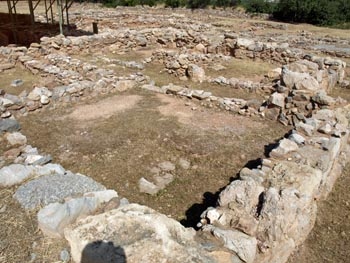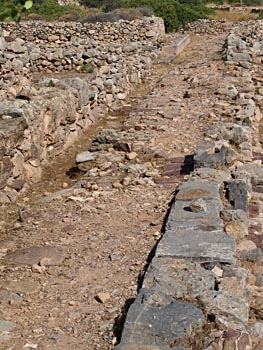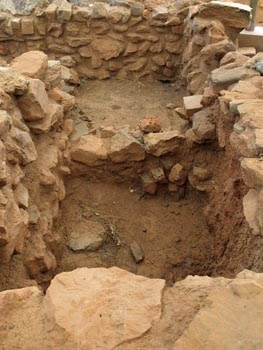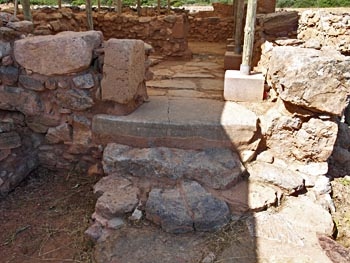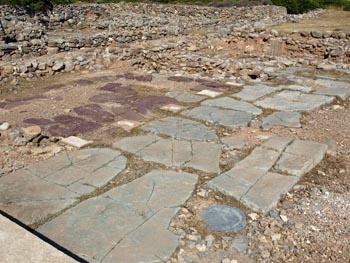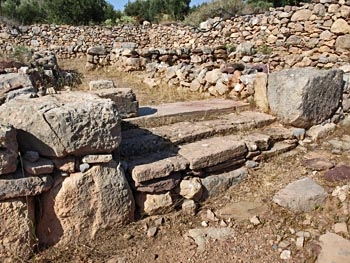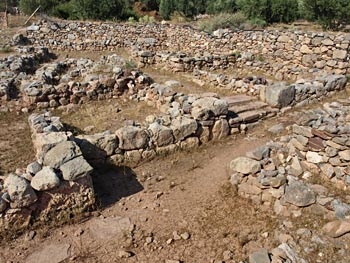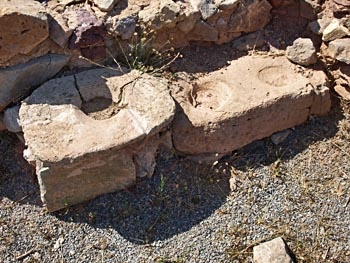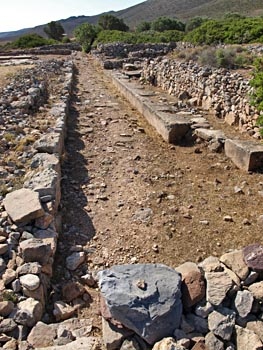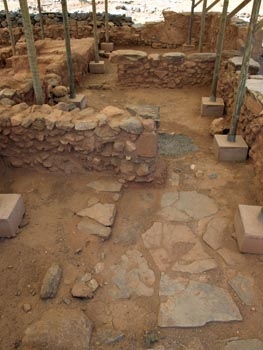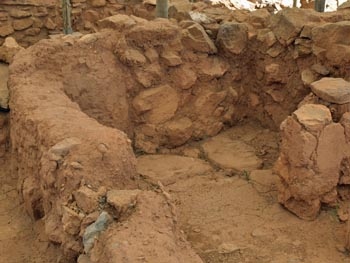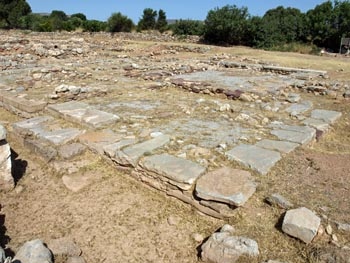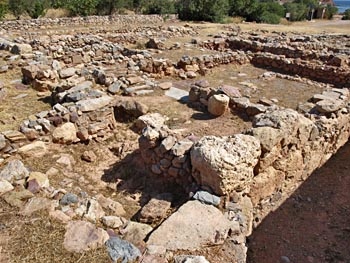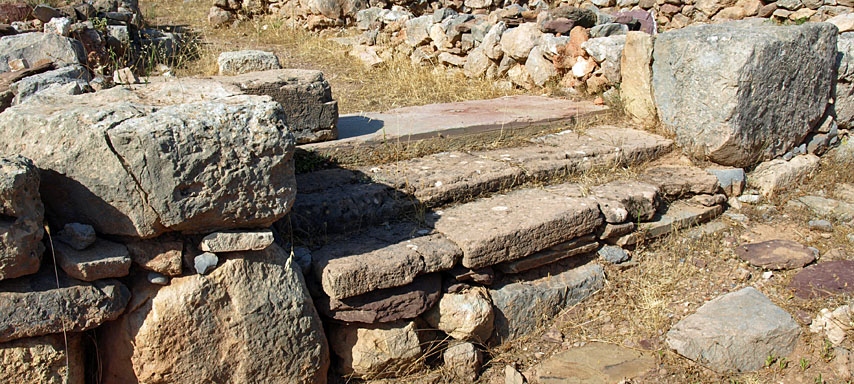
An East coast Minoan town
The Bronze Age town, whose original name is not known, is situated at Rousolakkos two kilometres from the village of Palaikastro and some kilometres north of the Minoan town and palace of Zakros. The location of the town was important as it was on the east coast, with a large plain behind it and a harbour that was sheltered by an outcrop of rock called Kastri hill. A number of small settlements, individual houses, cemeteries, ossuaries and quarries were also found in the surrounding area.
The site was originally excavated between 1902 and 1906 by R. Bosanquet and R.M. Dawkins from the British School of Archaeology in Athens, and subsequently by Hugh Sackett and Mervyn Popham from 1962 to 1963. Sackett and MacGillivray have been excavating at the site on and off since 1986 until the present and have uncovered new buildings that formed part of the town at Palaikastro.
The Early Minoan period
The site was occupied from at least EM II. Two small buildings dating from EM IIA were uncovered and it is felt that these were permanent homes because an ossuary with pottery from the same period was located near to each building. In EM IIB a new monumental structure was built. This building was comparable to other similar buildings that also went up around this time at Vasiliki, Myrtos, Knossos, Tylisos and Phaistos.
In the immediate prepalatial period (EM III-MM IA) no new structures were found in the area of Palaikastro although there may have been a house on the site of Building 5, where pottery from this period was found. A large building on Kastri produced pottery from this period and an ossuary at Patema also appears to date from the EM III-MM IA period.
The protopalatial period
The town itself developed during the Protopalatial period (MM IB-MM IIA). Evidence for this development was found below blocks X, G, E and 0. A cemetery at Tou Galeti He Kephala was opened up in this period. Large public buildings were being constructed as early as the Old Palace period as shown by the discovery of a mason's mark similar to one used in the Old Palace period at Knossos. Also around this time the peak sanctuary on Petsophas was inaugurated.
It seems that during this period the Minoans also established a system of roads guarded by watchtowers. There were possibly four or five towers along each of the two routes which left Palaikastro.
The neopalatial period
A large number of houses were built during the MM IIIB-LM IA period and they remained in use until they were destroyed in LM IB. The reason for so much building taking place at this time was the destruction of large parts of the town at the end of MM IIIA, almost certainly by an earthquake. The new town expanded northward from the old Blocks to Buildings 2 and 3, as well as possibly 4 and 5 from the latest excavations. The town also grew to the west with the building of Block K.
In LM IA Building 1 was constructed. This building was uncovered during the 1986-8 excavations. Evidence suggested that this building was more than simply a large house. Firstly all four exterior walls were built of ashlar masonry, the first such building to be found at Palaikastro.
A carved statuette with a head of serpentine and eyes of rock crystal was found in an area just outside Building 1 and the excavators believe that this building may have been part of a shrine or a temple. In their view it is possible that this shrine or temple took on the important role previously filled by the peak santuary which was now going out of use. If so, then Building 1 may be the first identifiable public building to have been uncovered in a hundred years of excavations at Palaikastro.
The postpalatial period
In LM IB the town continued to grow. However at the end of LM IB a series of destructions by fire took place. While many of the palaces, towns, settlements and villas of Minoan Crete were destroyed and abandoned during this period, serviceable buildings at Palaikastro were reoccupied almost immediately but not all of the town was reoccupied and few buildings were renovated or rebuilt. But in LM IIIA2 and LM IIIB, large scale building took place in Palaikastro and the population increased as the town was reoccupied. Houses were also built close to the sea and on Kastri. During the LM IIIB period it seems that an earthquake once again destroyed much of the town, after which it was partially re-occupied and then abandoned. The farms and cemeteries also went out of use. There seems to have been a small temporary settlement in LM IIIC on the Kastri Hill after which Palaikastro ceased to be inhabited until the Geometric period.
Central planning
What is interesting about Palaikastro, which grew to be the second largest town in Crete after Knossos, is the fact that it seems to have been largely planned by a central authority. The town is arranged in blocks which the original excavators named with letters from the Greek alphabet, beta, gamma and delta etc. A main street ran for a length of 145 metres through the town and three very narrow streets ran off the main street at right angles, one of them for a length of 70 metres. More than half the width of the main street was taken up by a raised pavement.
Each block consists of four or five houses, one of which tends to be larger than the others and contains more significant architectural features, for example, a facade of ashlar masonry. In particular, the largest house in several of the blocks contained what has been named a Palaikastro Hall, a room with a sunken area in the centre surrounded by four pillars. Of the four Palaikastro Halls identified, three had a lustral basin at close proximity. It has been suggested that each block may have been occupied by people related to each other, either an extended family or members of a clan.
It is assumed, given the location of the town, that the main economic activities of the inhabitants would have been agriculture and trade. But these two basic strands of the local economy also supported a wide variety of craft activities. Weaving was a major activity throughout the town as shown by the number of loomweights found all over the site. The manufacture of products in metal, stone and ivory, for which the raw materials would have been imported, provided the elite families with high status goods made from rare materials. The houses of these families were in some cases decorated with wall paintings, although only fragments have been found. Finally the production of pottery, both for consumption in the town and for export to other areas of Eastern Crete would have been a major activity. When House 1 at Petras was excavated, for example, it was found that two-thirds of the pottery had been made at Palaikastro. A potter's kiln has been excavated but it can't have been the only one, and potter's wheels have also been uncovered.
Evidence of cult activity was found throughout the site and on a scale not found elsewhere. Among the finds of a religious or cult nature were incense burners, rhyta, triton shells, large stone baetyls, horns of consecration and double axes. However the most important cult find was a carving in ivory of a young male believed by excavators to be a Minoan forerunner of the Diktaian Zeus. The ivory figure had been deliberately broken either by disillusioned worshippers or by the Mycenaeans when they arrived in the town.
A number of cemeteries were discovered by the original excavators and these circle the Minoan town. In Early Minoan Crete communal burials were practised with the bones of the deceased buried with their grave goods in a secondary burial after the body had fully decomposed. In central south Crete burials were in tholos tombs, but in north and east Crete house tombs were constructed. It is thought that the house tombs at Palaikastro contained two areas, one open area in which the body decomposed before the bones were collected and placed in the second, smaller area, an ossuary, together with the grave goods. In Late Minoan Crete after the arrival of the Mycenaeans, there was a move towards individual burials in larnakes, a number of which were found in the cemeteries of Palaikastro.
A large area of the earliest excavations at Palaikastro has since been covered over again with earth. The area of the excavation that was left exposed suffered damage during the Second World War and later from the activities of a bulldozer. Locals also took much of the finer stonework for building purposes so by the time the site was revisited in the 1960s it was overgrown and the ground plans drawn by the early excavators were, in places, hard to follow.
Below I describe in detail one of these blocks, which contains many of the features that were repeated in the other blocks excavated in the town. Other blocks will be described more briefly.
Block Beta
Click here for the original planThe first block to be excavated in the town itself was block B (see plan). This block consisted of five houses, one very large one and four much smaller ones. The large house (rooms 1-22), known as House B, had 22 rooms and what the excavators called megalithic outer walls. There was a courtyard in the south east corner which was entered from the direction of the harbour. A verandah was uncovered at the west end of the south east court near room 12. Two square and four round limestone column bases on which wooden pillars had rested were found here and they alternated between square and round bases.
Entry to the house was through a porch (room 8) which once held a wooden bench. The threshold was made of ironstone and it separated the porch from the vestibule (room 7), which led into the main room of the house (room 6). Rooms 6 and 7 formed an L shaped whole but room 6 was clearly different. It had a paved floor in the centre of which was a sunken area covered with white plaster and surrounded by a border of regular slabs. At the four corners of the sunken area, round column bases were found. The area in the middle would have been exposed to the open sky. It was possibly created to allow light and air into the building as there was nothing to indicate that the area had originally been a hearth. This slightly sunken space with four pillar columns at each corner was found repeated in a number of the largest houses in other blocks in the town and will be referred to here as a Palaikastro Hall.
This type of hall was long believed to have been unique to Palaikastro, but there may have been an example in House B2 at Mochlos where a building of ashlar masonry contained both a pier and door partition and what the excavator called an impluvium, but which is in fact a hall of the Palaikastro type.
The main finds were made in the adjoining rooms. Room 2 was the anteroom for what the excavators called a bathroom (room 3). However, this room blocked an already existing drain which rather undermines the theory that it was a bathroom. It is far more likely to have been a lustral basin, since these did not have drainage. Although many of lustral basins stand alone, a number were located very close to Minoan Halls or in this case the Palaikastro Hall, the particular style of hall represented in the larger houses here with their four pillars around a slightly sunken area in the middle of the room.
Among the ceramics found in rooms 2 and 3 were examples of Kamares Ware. Room 5 was originally bigger but a staircase was built to the left of the door when the second floor was added. Four steps from this staircase remain in situ. Opposite the entrance to room 5 there were two steps down into a compartment where an enormous number of plain cups were found. Room 5 may have been a kitchen. Finds included three female figurines of clay, the clay head of an ox and marine style sherds. Space 20 may have become a cellar after reconstruction as 40 plain cups and many more broken ones were found there as well as stucco fragments which, when put together formed part of a horns of consecration.
Rooms 10 and 13 were magazines entered from above. Several hundred vases were found here and the largest of them lined the walls. The original entrance to rooms 10 and 13 may have been from entrance room 12. This entrance was blocked by a staircase when the upper floor was built, at which point 10 and 13 may have been turned into storerooms.
Room 9 had a floor of stamped clay. The room suffered fire damage and may have been a storage room for lamps, in which case oil may have been stored here as well. This would have made the destruction fire even more intense. Several large fire-damaged steatite lamps found here.
Room 14 had a good flagstone pavement but the wall facing the street was so badly damaged that is not known if there had been a door here. In the middle of the room was a column base. A larger column base, fallen from the room above, lay on top of it, suggesting that there had been a pillar on both the ground floor and the first floor. All the rooms contained cooked red soil from the upper floor which would have been built using mud bricks. The excavators believed that the mud bricks had only been sun dried before use but were baked in the fire that destroyed the building. Plaster fragments painted in various colours had also fallen from above as had the flagstone floor of the room above room 10. Room 14 had been floored with kiln-baked earthenware tiles. Room 15 was identified as a bathroom.
Block Gamma
Click here for the original planIt is not desirable to describe all the blocks in the same detail as Block Beta as many of the same features are repeated. Reports on these blocks will therefore concentrate on the most important aspects.
Block Gamma contained four buildings of which one was the most important. The remaining buildings tended to have more rooms than some of the smaller buildings in Block Beta. The building that stands out as the most important house in this block consisted of rooms 1-12. Again, entry is through a vestibule with a small recess on the left containing a bench. In this house the threshold is on the right. The vestibule was like a porch with the main door beyond.
The main doors opened into room 1. The Palaikastro Hall, room 3, was to the left, past a staircase. Near the remains of the slab pavement are 2 pillars, all that is left of the four pillars once here. At a later point the main hall was much altered. The western half was filled with a staircase and a small room whose walls supported a second flight of stairs. A steatite lamp was found in this room. Below these structures there had originally been a lustral basin, which had been filled in when the stairs were being built.
Rooms 9 and 10 were both well paved, the first with cement the second with stone slabs. A pithos, amphorae and a pestle were discovered in room 9. Area 11 was a courtyard formed by the space between two different houses. Room 12 opened onto the street and formed a side entrance to the house.
The other houses in the block were made up of rooms 13-22; rooms 23-32; and rooms 33-38. In this last building rooms 37 and 38 may have been a shop. The whole width of room 37 opens onto the side street, while a double entrance leads into room 38, immediately behind room 37. This room contained a stone sink connected to a drain which ran through room 37 and out into the street. The channel was covered with stone slabs. The sink and drain, together with jars and what may have been weights suggests an industrial purpose. Perhaps the two rooms were a shop with a rear storeroom and workroom.
Block delta
Click here for the original planAt over 1800 square metres even before it was fully uncovered, Block Delta was the largest block found at Palaikastro. Unfortunately the best house in this block had been damaged by locals taking away the fine cut pieces of stone. The west end of the building had been completely ruined. A great deal of rebuilding in Minoan times had raised the level in this area so that the pavement in the road outside is not the original, which would have been at the level of the road itself.
A number of buildings were originally identified. Within rooms 1-16 where an absence of doorways made it difficult to understand the plan, room s 8-16 were identified as making up one house. A second, very large, building comprised rooms 18-40 while rooms 43-48 contained two very small buildings, with three rooms each (43-45 and 46-48).
The house in rooms 18-40 had seen a lot of rebuilding. The main feature of the earlier house was the Palaikastro Hall in room 19 with its four pillars at the corners of a square of unpaved space, all lying below the floor level of the later house. The entrance, now concealed by later structures, must have been on the mains street from 20 or 21.
When the second house was built the Palaikastro Hall was covered up and a fresh entrance made at a higher level. The level of the street was also raised and a new facade was built for rooms 20-36. Room 23, which the excavators called an impluvium, belongs to the later period. It consisted of a paved area 3.5m square, which was open to the sky as it has a drain running down into the street This square was surrounded by a higher pavement above the level of the earlier house. The paved square in area 40, made of two huge slabs, may have been a similar structure. Room 38 contained lamps and a lamp stand.
Rooms 43-48 had been inhabited from the earliest Minoan times and they were continuously occupied until the period of desertion when Palaikastro was finally abandoned. Room 47 was a back entrance, while rooms 43-46 and 48 were storerooms.
Finds: The most interesting finds from Block Delta came from Room 44 where LM IIIA vases plus clay objects connected with the cult of a snake goddess were found. Excavators found four female figurines dressed in long skirts. On three of the figures, the arms, though broken, were originally outstretched while the fourth holds a striped snake in her arms. The figures have no headgear and their bodices cover their breasts. It seems likely that the group were placed with the woman with the snake in her arms in the centre and the other women dancing hand in hand.
Clay doves were also found. These probably represented doves in the process of perching on a trinity of sacred pillars. Each dove had a hole underneath so they had originally been connected to something. Also found were the remains of 44 conical shaped cups which had all been originally attached to some base, possibly a large bowl, with the painted side of the cup facing out. All these objects had been deliberately broken and then put away in room 44.
Why no palace?
The current excavators of the site believe there may be a palace to the south of the town in an area which has yet to be excavated. The palace at Zakros, further south on the east coast, is located in just such a position. Castleden, however, argues that the absence of a palace may mean that the craft workers were able to carry out their trade geographically separated from the palace, although the possibility cannot be excluded that their work was directed by a central authority at Zakros.
To the south of the site a Peak Sanctuary was excavated by the British on the summit of Petsophas, 225 metres high. It proved to be one of the richest and most important Middle Minoan Peak Sanctuaries and was certainly still in use in Late Minoan I, when a small cult building was erected.
A large number of small clay figurines of men and women, representing the people making the dedicatory offerings were found, which provided a lot of information about the dress and hairstyles of the period. Votive models of human limbs and stone offering tables with Linear A inscriptions were also found.


